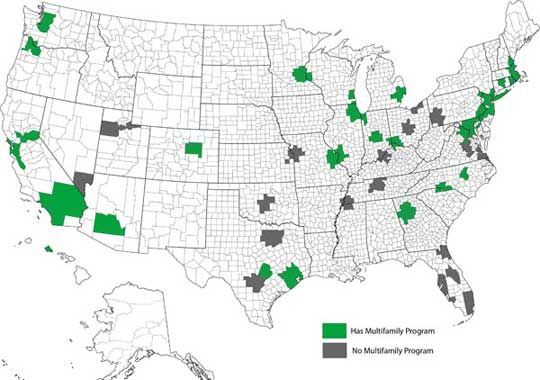The greater New York-New Jersey area has more than 2,800,000 apartment units that make up 37 percent of the total housing stock. Despite multi-family units being a sizable chunk or real estate in and around the Big Apple, energy efficiency spending in that sector equates to just 2 percent of the total for all energy-efficiency programs.
The meager rate of investment still earned the New York region a title as one of the leaders in multi-family energy efficiency, according to a new report from the American Council for an Energy-Efficient Economy: Scaling up Multifamily Energy Efficiency Programs: A Metropolitan Area Assessment.
The report creates a baseline for the relatively sad state of multi-family energy efficiency programs across the U.S. Boston and Austin were the only two cities where program dollars that go to multi-family accounted for more than 10 percent of the overall spend.

One of the problems is the split incentive, as many people in apartments are renters, and even if they own, many older buildings are not submetered. Designing programs that address who pays, and benefits, from efficiency upgrades is critical. Another problem is that a sizeable chunk of low-cost apartments do not receive government subsidies and so they might not be covered by other utility low-income programs.
In Massachusetts, where some of the most money is spent, one business has already popped up to help the multi-family sector. WegoWise works with public housing authorities and private building owners to squeeze energy savings out of apartment buildings.
The ACEEE report recommended not only increased spending, but also more programs to take on deeper retrofits, rather than just specific one-off energy-efficiency measures. To showcase the best in breed, ACEEE is planning a follow-up report that will highlight some of the best energy-efficiency programs in the country.
“While it is encouraging that we found 50 energy efficiency programs designed for multifamily buildings [as there were multiple programs in several of the 30 metro areas], there is still a lot of room to reach more buildings and save more energy,” Kate Johnson, Senior Analyst at ACEEE, wrote in a blog post.
Just how much energy? ACEEE estimates that the leading retrofit programs save 15 percent on electricity and up to 30 percent on gas. Those savings, however, would mean expanding or introducing comprehensive programs in many metropolitan areas, including some of the largest (Dallas, Miami) that currently don’t have multi-family programs.
A case study on energy efficiency retrofits in a multi-family building, by NYSERDA:



